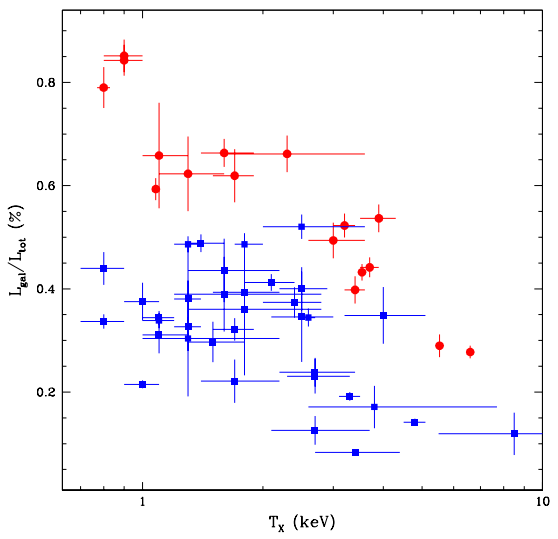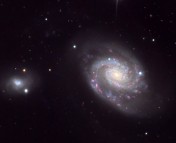Title: The XMM Cluster Survey: The Stellar Mass Assembly of Fossil Galaxies
First Author: Craig D. Harrison
First Author Institution: University of Michigan
How do you describe a fossil? Old? Imprinted? Dead? Pristine? A link to the past? As it turns out, the word fossil has been used to describe a distinct population of galaxies and systems of galaxies in our universe. Hierarchical structure formation models indicate that small things build larger things over cosmic time. When groups and clusters of galaxies form, dynamical friction causes the galaxies to lose momentum and kinetic energy, which can ultimately lead galaxies to merge. This dynamical friction has the greatest effect in high density regions, which causes mergers to create a large brightest cluster galaxy (BCG) at the center of these systems. Observations have identified a population of clusters that have a very large BCG, but not very many bright companions (ie, a magnitude gap exists) and called these Fossil Galaxies in Fossil Systems. The use of word fossil here is perfect because the BCG appears to live in a “dead” or depleted environment, and the entire merger history should be imprinted in its stellar population.
So what can we learn from these fossil systems? Because of small samples, much of what we already know has come from simulations. These simulations indicate that fossil systems gain a large fraction of their mass at high redshift and earlier than non-fossil groups. One hypothesis is that growth of fossils was dominated early by in-fall of massive satellites which boosted the size of the fossil galaxy relative to its cousins in non-fossil systems, which evolved slightly more passively. Another hypothesis suggests the fossil systems formed as such, and therefore don’t rely on physical mechanisms like dynamical friction to grow the fossil galaxy. Instead, the conditions were such that the cluster gas was funneled to form the fossil galaxy in the first place, leaving less material to form other bright galaxies.
Harrison et al. use the expansive Sloan Digital Sky Survey (SDSS), along with the XMM Cluster Survey (XCS), to identify a very pure sample of fossil systems. They do so by using a magnitude gap not defined by the first and second brightest galaxy, but the first and fourth brightest galaxy. If this gap is greater than 2.5 and the cluster or group has a significant level of X-ray luminosity, then the system is a “fossil system” and the BCG is a “fossil galaxy”. They argue that this criteria allows for a cleaner sample, but for all the details I refer the reader to the paper itself.
So the question is, does this magnitude gap represent anything about the cluster? The authors find that several important qualities scale with this observed feature. Stellar mass of the dominant galaxy, the fraction of light contained in the dominant galaxy, and the luminosity of the dominant galaxy all seem to scale with the magnitude gap. The authors note that if repeated mergers within the system are responsible for their findings, a couple of scenarios are possible. In the first case, the dominant galaxy finds a way to eat lots of smaller galaxies while leaving the 2nd-4th brightest galaxies untouched. This means that dynamical friction wouldn’t be very important since massive objects are affected more by this force. In the second case, the dominant galaxy could participate in smaller mergers, but then develop the magnitude gap with a single large merger with a galaxy of equal mass. Both scenarios indicate more efficient merging in fossil systems. It is also important to note that whatever mechanism leads to a fossil system must work on all mass scales (groups-clusters) since fossil systems exist throughout that range.

A plot of the fraction of light in the dominant galaxy vs. the total system luminosity where the red points are fossil systems and the blue points are non-fossils. It is striking how the fossil systems are a selection of the top of the population.
Is it possible to distinguish between the different evolution scenarios with an experiment? One way to do so would be to look at the diffuse stellar component (DSC) that exists around the dominant galaxy in a group/cluster. It is composed of material that has been stripped from cluster galaxies during dynamical interactions. Detecting structure in the DSC could indicate some recent activity through mergers and that the fossil galaxy is still evolving. Little structure detection in these systems would indicate a quiescent past, up to z < 1 and a non-detection of the DSC would indicate that major mergers had nothing to do with the evolution of the fossil galaxy.





Trackbacks/Pingbacks